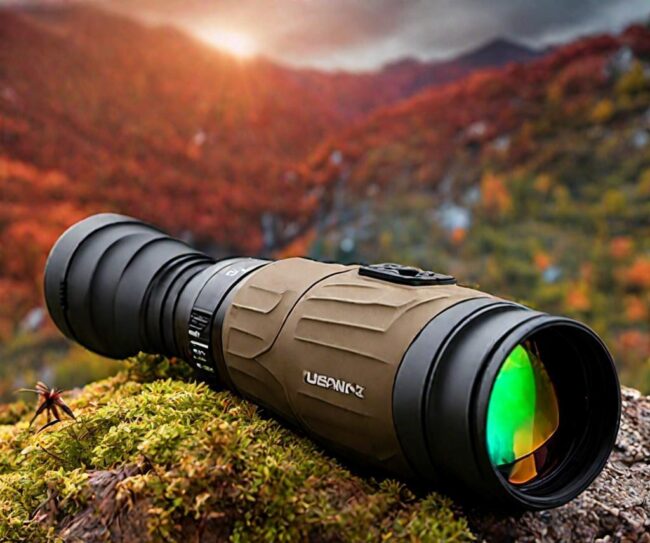Thermal imaging technology, often seen in the form of thermal monoculars, is a tool that detects infrared radiation emitted by objects. Its capability to visualize temperature variations has led to its widespread adoption in various fields. But a common question arises: Can thermal monoculars be used in daylight? Let’s delve into this topic to provide a comprehensive answer.

Understanding the Basics
Before we address the main question, it’s crucial to understand how thermal imaging functions.
Infrared Radiation and the Electromagnetic Spectrum
Every object emits infrared radiation, which is essentially heat energy. This radiation is invisible to the naked eye because it falls outside the visible spectrum. Instead, it’s a part of the broader electromagnetic spectrum, located between visible light and microwaves.
Thermal Imaging Mechanism
Thermal imaging devices, including monoculars, detect this emitted infrared radiation. The device then processes this information, translating different intensities of radiation into varying shades or colors to represent temperature differences. This results in a thermal image or thermogram.
Daylight vs. Nighttime: Does It Matter for Thermal Imaging?
Light Independence
Thermal imaging, by its very nature, is independent of visible light. Since it focuses on detecting heat rather than light, the presence or absence of sunlight doesn’t directly influence its operation. This is why thermal imaging is popular for nighttime operations, such as military surveillance or wildlife observations.
Daylight Operations
In daylight conditions, thermal monoculars function just as effectively as they do at night. The sun does not “blind” the device or impede its functionality. In fact, in some scenarios, using a thermal monocular during the day can offer unique advantages:
- Spotting Hidden Objects: Camouflaged animals or individuals can blend seamlessly with their surroundings in visible light. However, their heat signatures remain distinct, making them detectable by thermal monoculars even during the day.
- Safety Operations: In search and rescue missions, especially in vast landscapes, a lost individual might be hard to spot with the naked eye during the day due to terrain, vegetation, or distance. A thermal monocular can highlight the person’s heat signature, aiding in quicker location and rescue.
Considerations for Daylight Use
While it’s established that thermal monoculars can be used in daylight, there are specific considerations to bear in mind:
Solar Heating
During daylight, the sun heats objects, sometimes unevenly. This can lead to a phenomenon known as solar loading, where objects absorb heat from the sun, making their surface temperatures different from their core temperatures. In such scenarios, the heat signature captured by a thermal monocular might be influenced more by the sun’s heating than by the object’s intrinsic temperature. Users must be aware of this aspect, especially when interpreting thermal data.
Reflected Infrared Radiation
Just as objects can reflect visible light, they can also reflect infrared radiation. In daylight conditions, especially in environments with multiple objects, there might be instances of reflected infrared radiation. This can sometimes create confusion in the thermal image, making it essential for users to understand the context of what they’re observing.
Contrast and Resolution
In certain daylight conditions, especially when temperatures are uniform across a landscape, the contrast in a thermal image might be reduced. It becomes crucial for the thermal monocular to have a good resolution and sensitivity to distinguish subtle temperature differences.
Modern Advances Enhancing Daylight Use
With technology’s progression, modern thermal monoculars come equipped with features that enhance their usability in daylight:
Image Fusion
Some advanced monoculars offer image fusion, where they combine visible light imagery with thermal imaging. This provides a more detailed and context-rich image, especially beneficial in daylight.
Advanced Algorithms
Modern devices often include sophisticated algorithms that can adjust for factors like solar loading or reflected infrared radiation, providing more accurate and clear thermal images.
Higher Sensitivity and Resolution
Technological advancements have led to thermal sensors with higher sensitivity and resolution, enabling them to pick up even minute temperature differences. This is particularly helpful in daylight conditions with low thermal contrast.
Conclusion
To answer the primary question: Yes, thermal monoculars can indeed be used in daylight. Not only are they effective during the day, but in certain scenarios, they can also offer unique advantages over other optical devices. However, users should be mindful of the specific challenges daylight poses, such as solar loading and reflected infrared radiation. Thankfully, with the rapid evolution of technology, many of these challenges are being addressed, making thermal monoculars versatile tools for both day and night operations.
